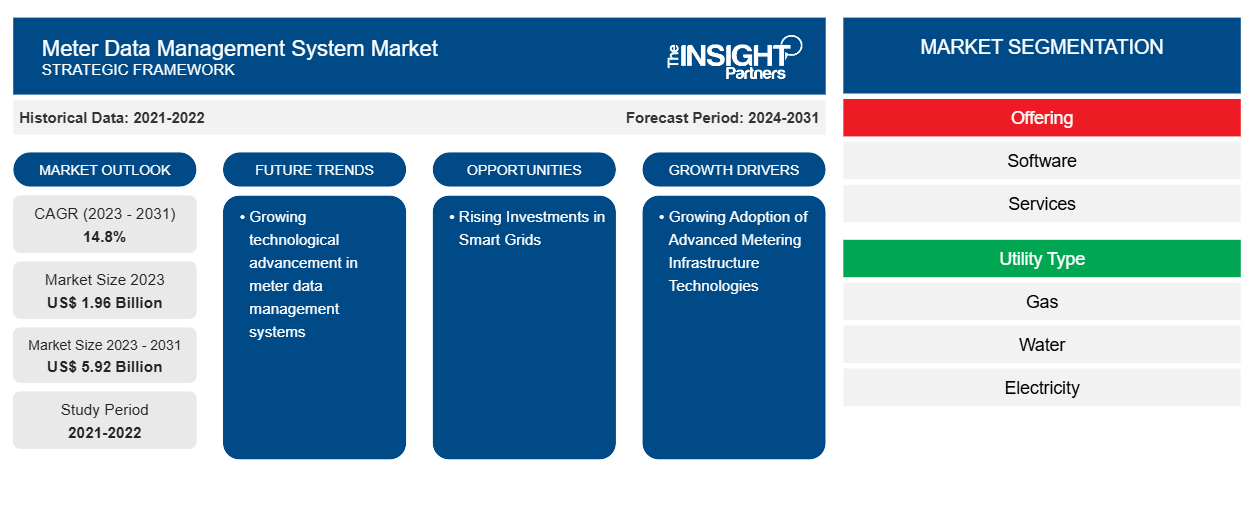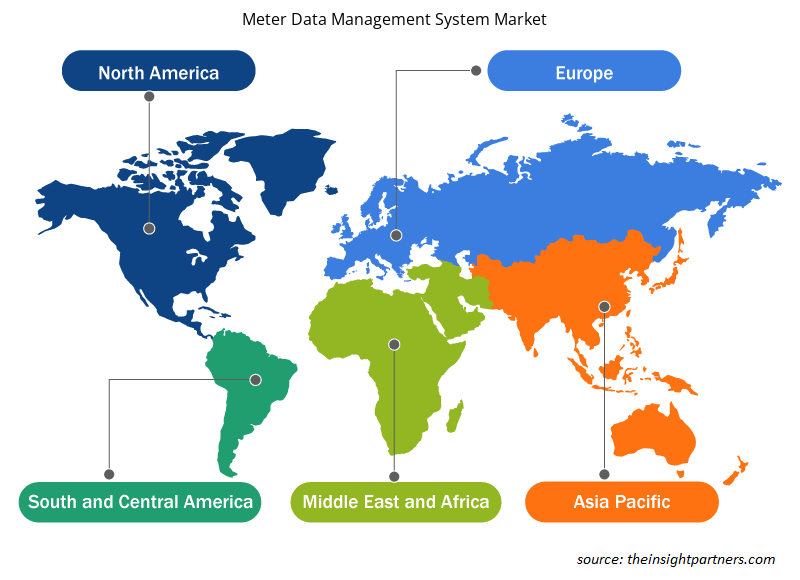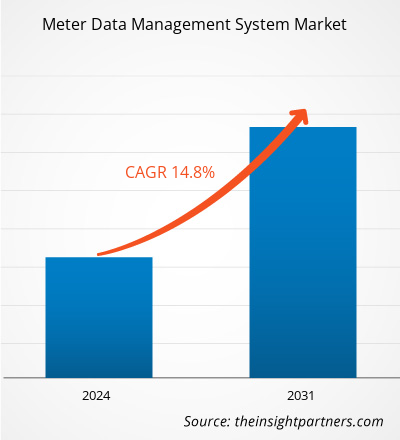The meter data management system market size is projected to reach US$ 5.92 billion by 2031 from US$ 1.96 billion in 2023. The market is expected to register a CAGR of 14.8% in 2023–2031. The growing technological advancement in meter data management systems is likely to remain a key meter data management system market trend.
Meter Data Management System Market Analysis
Increasing adoption of advanced metering infrastructure technologies is one of the major factors fueling the growth of the market. Also, regulatory mandates and legislative compliances for smart metering and a growing need for greater customer service and utility efficiency are driving the market growth globally. Furthermore, the rising investments in smart grid projects and government initiatives in supporting the installation of smart meters in developing nations are expected to create an opportunity for the growth of the market in the forecasted period. Additionally, the rising use of next-generation meter data management solutions by utilities is expected to propel the growth of the market in the forecasted period.
Meter Data Management System Market Overview
The meter data management system assists in receiving, validating, storing, and analyzing large amounts of data, which can be used by different utilities for various applications such as billing, managing customer information, and grid operational management systems. Moreover, utilities can produce actionable insights for proactive and preventative maintenance when the system is integrated with other utility systems like Advanced Distribution Management, Mobile Workforce Management, and Geographic Information systems. This helps to enhance operations and guarantee that their customers have a consistent supply of energy. Additionally, the system gives agents more precise and fast information to promptly respond to consumer concerns. Better data accuracy promotes better decision-making and enforceable processes.
Customize This Report To Suit Your Requirement
You will get customization on any report - free of charge - including parts of this report, or country-level analysis, Excel Data pack, as well as avail great offers and discounts for start-ups & universities
Meter Data Management System Market: Strategic Insights

- Get Top Key Market Trends of this report.This FREE sample will include data analysis, ranging from market trends to estimates and forecasts.
You will get customization on any report - free of charge - including parts of this report, or country-level analysis, Excel Data pack, as well as avail great offers and discounts for start-ups & universities
Meter Data Management System Market: Strategic Insights

- Get Top Key Market Trends of this report.This FREE sample will include data analysis, ranging from market trends to estimates and forecasts.
Meter Data Management System Market Drivers and Opportunities
Growing Adoption of Advanced Metering Infrastructure Technologies
The adoption of advanced meter infrastructure (AMI) technology is fueled by a number of advantages offered by advanced metering technology, including the capacity to identify outages and the ability to facilitate end users' real-time energy consumption patterns. In addition, the market is growing due to the rise in energy demand, statutory requirements for smart metering, government mandates, and the demand for better utility efficiency and customer service.
Rising Investments in Smart Grids
As homes and companies incorporate a growing number of electronic gadgets and technical capabilities, the need for utilities to learn about changing electricity demand in real-time is increasing. In this case, integrating smart grids can assist in giving all grid customers more dependable electricity. To cater to this, the governments of various countries are making various investments in smart grids. For instance, in September 2022, the US Department of Energy (DoE) was working on seeking input on a US$ 10.5 billion program for smart grids and other upgrades to strengthen the electricity grid of the country. This funding is allocated in three parts, under which US$ 2.5 billion will be used for grid resilience, US$ 3 billion for smart grids, and US$ 5 billion for grid innovation. Thus, the rising investment in the smart grid infrastructure is expected to create an opportunity for the growth of the meter data management system market.
Meter Data Management System Market Report Segmentation Analysis
Key segments that contributed to the derivation of the meter data management system market analysis are offering, utility type, application, and end-user.
- Based on offering, the meter data management system market is bifurcated into software and services. The software segment held a larger market share in 2023.
- Based on utility type, the market is segmented into gas, water, and electricity. The electricity segment held a larger market share in 2023.
- Based on application, the market is segmented into smart grid, microgrid, energy storage, EV charging, and others. The smart grid segment is anticipated to grow in the forecasted period.
- By end-user, the market is segmented into residential, commercial, and industrial. The residential segment is anticipated to grow in the forecasted period.
Meter Data Management System Market Share Analysis by Geography
The geographic scope of the meter data management system market report is mainly divided into five regions: North America, Asia Pacific, Europe, Middle East & Africa, and South America/South & Central America.
North America is anticipated to witness significant growth in the meter data management system market. The market in this region is segmented into the US, Canada, and Mexico. The region is witnessing a rise in the demand for electricity owing to the economic and population growth. According to the International Energy Agency (IEA), in 2021, the total electricity production was 5,397,346 GWh, 19% of the global share. In addition, according to the US Energy Information Administration, the total electricity consumption in the US in 2022 was ~4.07 trillion kWh. As the region is witnessing a continuous rise in electricity consumption, the need for meter data management systems is increasing in the region.
Meter Data Management System Market Regional Insights
The regional trends and factors influencing the Meter Data Management System Market throughout the forecast period have been thoroughly explained by the analysts at The Insight Partners. This section also discusses Meter Data Management System Market segments and geography across North America, Europe, Asia Pacific, Middle East and Africa, and South and Central America.

- Get the Regional Specific Data for Meter Data Management System Market
Meter Data Management System Market Report Scope
| Report Attribute | Details |
|---|---|
| Market size in 2023 | US$ 1.96 Billion |
| Market Size by 2031 | US$ 5.92 Billion |
| Global CAGR (2023 - 2031) | 14.8% |
| Historical Data | 2021-2022 |
| Forecast period | 2024-2031 |
| Segments Covered |
By Offering
|
| Regions and Countries Covered | North America
|
| Market leaders and key company profiles |
Meter Data Management System Market Players Density: Understanding Its Impact on Business Dynamics
The Meter Data Management System Market is growing rapidly, driven by increasing end-user demand due to factors such as evolving consumer preferences, technological advancements, and greater awareness of the product's benefits. As demand rises, businesses are expanding their offerings, innovating to meet consumer needs, and capitalizing on emerging trends, which further fuels market growth.
Market players density refers to the distribution of firms or companies operating within a particular market or industry. It indicates how many competitors (market players) are present in a given market space relative to its size or total market value.
Major Companies operating in the Meter Data Management System Market are:
- ABB Group
- Aclara Technologies LLC (Hubbell Incorporated)
- Diehl Stiftung and Co. KG
- Eaton Corporation
- Honeywell International
- Itron Inc.
Disclaimer: The companies listed above are not ranked in any particular order.

- Get the Meter Data Management System Market top key players overview
Meter Data Management System Market News and Recent Developments
The meter data management system market is evaluated by gathering qualitative and quantitative data post primary and secondary research, which includes important corporate publications, association data, and databases. The following is a list of developments in the market for speech and language disorders and strategies:
- Siemens Smart Infrastructure relaunched its leading and proven smart meter data management software EnergyIP, focusing on enhancing user experience. This stems from increasing requirements for better data quality and further automation, leading to a focus on workflow improvements and user-centricity. Now, the software collates all relevant data on one screen, making it easier to understand and identify correlations and root causes through interactive visualizations and shortcuts. The latest EnergyIP Mosaic software is intuitive and efficient with noticeably fewer clicks, which leads to task time reduction by up to 85 percent.. (Source: Siemens, Press Release, 2023)
- Siemens Limited and Tata Power Delhi Distribution Limited (Tata Power-DDL) jointly announced the successful deployment of Smart Metering Technology for over 200,000 Smart Meters in North Delhi. The state-of-the-art EnergyIP Meter Data Management System installed and commissioned by Siemens enables timely and accurate collection of electricity meter data leading to increased visibility of the consumer network and reduction in carbon emissions. (Source: Siemens, Press Release, 2022)
Meter Data Management System Market Report Coverage and Deliverables
The “Meter Data Management System Market Size and Forecast (2021–2031)” report provides a detailed analysis of the market covering below areas:
- Market size and forecast at global, regional, and country levels for all the key market segments covered under the scope
- Market dynamics such as drivers, restraints, and key opportunities
- Key future trends
- Detailed PEST/Porter’s Five Forces and SWOT analysis
- Global and regional market analysis covering key market trends, major players, regulations, and recent market developments
- Industry landscape and competition analysis covering market concentration, heat map analysis, prominent players, and recent developments
- Detailed company profiles
Frequently Asked Questions
What will be the market size of the global meter data management system market by 2031?
The global meter data management system market is expected to reach US$ 5.92 billion by 2031.
Which are the key players holding the major market share of the global meter data management system market?
The key players holding majority shares in the global meter data management system market are ABB Group, Aclara Technologies LLC (Hubbell Incorporated), Diehl Stiftung and Co. KG, Eaton Corporation, Honeywell International, Itron Inc., Kamstrup, Landis Gyr, Schneider Electric, and Siemens AG.
What are the driving factors impacting the global meter data management system market?
The growing adoption of advanced metering infrastructure technologies is the major factors that propel the global meter data management system market.
What are the future trends of the global meter data management system market?
Growing technological advancement in meter data management systems is anticipated to play a significant role in the global meter data management system market in the coming years.
What is the estimated market size for the global meter data management system market in 2023?
The global meter data management system market was estimated to be US$ 1.96 billion in 2023 and is expected to grow at a CAGR of 14.8% during the forecast period 2023 - 2031.
- Historical Analysis (2 Years), Base Year, Forecast (7 Years) with CAGR
- PEST and SWOT Analysis
- Market Size Value / Volume - Global, Regional, Country
- Industry and Competitive Landscape
- Excel Dataset
- Parking Meter Apps Market
- eSIM Market
- Advanced Distributed Management System Market
- Online Exam Proctoring Market
- Electronic Data Interchange Market
- Barcode Software Market
- Maritime Analytics Market
- Cloud Manufacturing Execution System (MES) Market
- Robotic Process Automation Market
- Digital Signature Market
Testimonials
Reason to Buy
- Informed Decision-Making
- Understanding Market Dynamics
- Competitive Analysis
- Identifying Emerging Markets
- Customer Insights
- Market Forecasts
- Risk Mitigation
- Boosting Operational Efficiency
- Strategic Planning
- Investment Justification
- Tracking Industry Innovations
- Aligning with Regulatory Trends
Yes! We provide a free sample of the report, which includes Report Scope (Table of Contents), report structure, and selected insights to help you assess the value of the full report. Please click on the "Download Sample" button or contact us to receive your copy.
Absolutely — analyst assistance is part of the package. You can connect with our analyst post-purchase to clarify report insights, methodology or discuss how the findings apply to your business needs.
Once your order is successfully placed, you will receive a confirmation email along with your invoice.
• For published reports: You’ll receive access to the report within 4–6 working hours via a secured email sent to your email.
• For upcoming reports: Your order will be recorded as a pre-booking. Our team will share the estimated release date and keep you informed of any updates. As soon as the report is published, it will be delivered to your registered email.
We offer customization options to align the report with your specific objectives. Whether you need deeper insights into a particular region, industry segment, competitor analysis, or data cut, our research team can tailor the report accordingly. Please share your requirements with us, and we’ll be happy to provide a customized proposal or scope.
The report is available in either PDF format or as an Excel dataset, depending on the license you choose.
The PDF version provides the full analysis and visuals in a ready-to-read format. The Excel dataset includes all underlying data tables for easy manipulation and further analysis.
Please review the license options at checkout or contact us to confirm which formats are included with your purchase.
Our payment process is fully secure and PCI-DSS compliant.
We use trusted and encrypted payment gateways to ensure that all transactions are protected with industry-standard SSL encryption. Your payment details are never stored on our servers and are handled securely by certified third-party processors.
You can make your purchase with confidence, knowing your personal and financial information is safe with us.
Yes, we do offer special pricing for bulk purchases.
If you're interested in purchasing multiple reports, we’re happy to provide a customized bundle offer or volume-based discount tailored to your needs. Please contact our sales team with the list of reports you’re considering, and we’ll share a personalized quote.
Yes, absolutely.
Our team is available to help you make an informed decision. Whether you have questions about the report’s scope, methodology, customization options, or which license suits you best, we’re here to assist. Please reach out to us at sales@theinsightpartners.com, and one of our representatives will get in touch promptly.
Yes, a billing invoice will be automatically generated and sent to your registered email upon successful completion of your purchase.
If you need the invoice in a specific format or require additional details (such as company name, GST, or VAT information), feel free to contact us, and we’ll be happy to assist.
Yes, certainly.
If you encounter any difficulties accessing or receiving your report, our support team is ready to assist you. Simply reach out to us via email or live chat with your order information, and we’ll ensure the issue is resolved quickly so you can access your report without interruption.





















 Get Free Sample For
Get Free Sample For